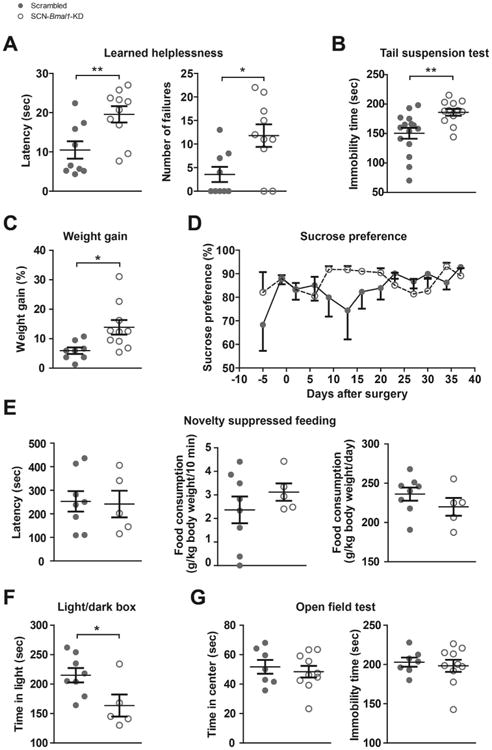Figure 2.

Disruption of circadian rhythms in the suprachiasmatic nucleus (SCN) leads to increased helplessness, despair, weight gain, and anxiety-related behavior. (A) In the learned helplessness paradigm, Bmal1-knockdown (Bmal1-KD) in SCN increases escape latency times (left) and number of escape failures (right). Data are shown as mean 6 SEM; *p ≤ .05, **p ≤ .01; latency time, t17 = 2.997; escape failures, t17 = 2.801 (Student t test); n = 9–10. (B) In the tail suspension test, Bmal1-KD in SCN increases immobility time. Data are shown as mean ± SEM; **p ≤ .01; t25 = 3.067 (Student t test); n = 12–15. (C) During the 5 weeks after adeno-associated virus injection, SCN-Bmal1-KD mice gain significantly more weight than control mice. Data are shown as mean ± SEM; *p ≤ .05; t16 = 2.693 (Student t test); n = 8–10. (D) In the sucrose preference test, Bmal1-KD in SCN has no significant impact on preference for sweet water. Data are shown as mean 6 SEM; interaction, F10,120 = 1.189, p = .352; time, F1,120 = 1.355, p = .2093; genotype, F10,120 = .8537, p = .3737; post hoc test, not significant (two-way repeated measures analysis of variance with Bonferroni posttest); n = 9–10. (E) Suppression of SCN rhythms does not change the aversion to eating in a novel environment (expressed as latency to begin eating) or total food intake (expressed per 10 minutes during the test or per day). Data are shown as mean ± SEM; not significant; latency time, t11 = 0.1600; food intake in novel environment, t11 = 0.9643; daily food intake, t11 = 1.173 (Student t test); n = 5–8. (F) SCN-Bmal1-KD mice spend significantly less time in the light compartment of a light/dark box, which is conventionally interpreted as an increase in anxiety-related behavior. Data are shown as mean ± SEM; *p ≤ .05; t11 = 2.430 (Student t test); n = 5–8. (G) In the open field test, Bmal1-KD in SCN does not alter spatial preference or total activity. Data are shown as mean ± SEM; not significant; time in center, t15 = 0.5319; immobility time, t15 = 0.4397 (Student t test); n = 7–10.
